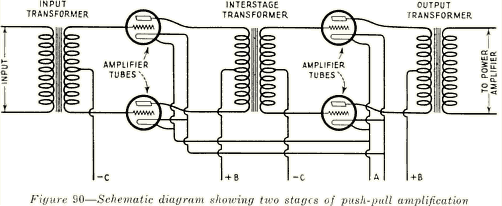133. Power Supply for Vacuum Tube Amplifiers.-Vacuum tubes require DC power for the
plate and grid circuits. DC is also used for lighting the filaments,
but this is not always necessary as there are many instances where AC is satisfactory for this purpose.
The DC power for the plate and grid circuits of the tubes can be obtained from batteries, motorgenerator sets, or rectifiers. All three of these sources are used in Photophone equipments, depending
on the design of the equipments. Batteries used for plate supply are called "B" batteries. Batteries used
to obtain a negative grid potential are called "C" batteries. Storage batteries are sometimes used to light
the filaments of the tubes. These batteries are commonly called "A" batteries. See Figure 89.
As an outgrowth of the battery designations "A," "B" and "C," it is customary to call the source of DC
power for the plate circuit of tubes, the "B" supply, and likewise the terms "A" and "C" supply are
used to designate the voltage supply for filaments and grids respectively.

The various types of motor-generator sets used to supply power to operate the vacuum tube amplifiers
are described in Chapter III. (Chapter III is omitted from this transcription. ED.)
134. Vacuum Tube Rectifiers.-Vacuum tube rectifiers used for "B" and "C" supply are often called SPU
(Socket Power Units). These rectifiers are similar to the rectifiers described for battery chargers in
Chapter V. Due to the high DC voltage required for the plate circuits of amplifiers, the Tungar bulbs are
not suitable for "B" supply rectifiers. The UX-281 Radiotron described in Section 120 is used to rectify
the AC to DC. Figure 92 is a schematic diagram of a typical vacuum tube rectifier using this type of
tube. The power transformer shown in the diagram "steps-up" the line voltage to a fairly high value
before it is rectified by the rectifying tubes. The rectifying action of these tubes is the same as that of
the Tungars described in sections 56 and 57. The output of the rectifiers is a pulsating direct current,
and is not satisfactory for plate or grid power supply and needs to be "filtered" (a process of removing
the variations of voltage). The filtering is accomplished by using condensers and an inductance. The
condensers serve as reservoirs for electricity, absorbing current when the voltage of the rectifier is
high, and supplying current to the load when the rectified voltage is low. The purpose of the inductance is to
smooth out the flow of current by preventing any rapid change of the current through it. A
voltage divider resistor is sometimes used across the load. Its use permits the tapping off of
various voltages for different purposes, but its presence is not required in the operation of the
rectifier.
8
